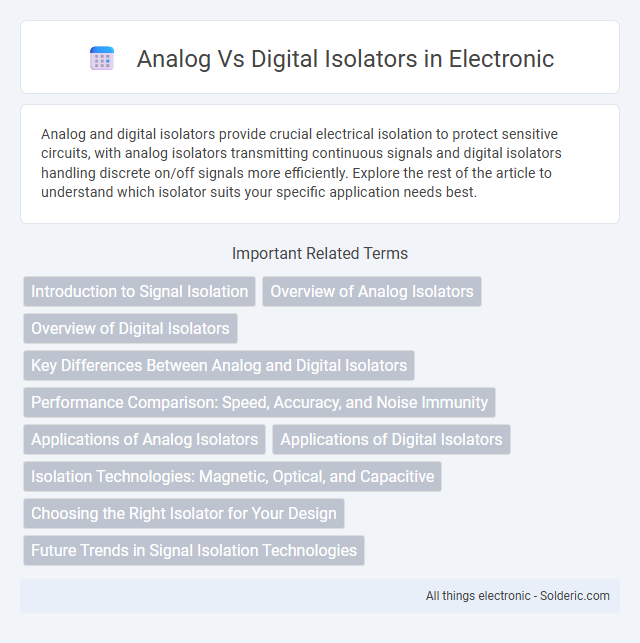Analog and digital isolators provide crucial electrical isolation to protect sensitive circuits, with analog isolators transmitting continuous signals and digital isolators handling discrete on/off signals more efficiently. Explore the rest of the article to understand which isolator suits your specific application needs best.
Comparison Table
| Feature | Analog Isolators | Digital Isolators |
|---|---|---|
| Signal Type | Continuous analog signals | Discrete digital signals |
| Isolation Method | Capacitive or magnetic coupling | Capacitive, magnetic, or optical coupling |
| Data Integrity | Prone to noise and signal degradation | High noise immunity, reliable data transfer |
| Speed | Limited by analog bandwidth | Higher data rates, typically up to several Mbps |
| Application Examples | Industrial control, sensor interfaces | Microcontroller interfaces, communication buses |
| Power Consumption | Moderate | Low to moderate |
| Cost | Generally higher | Generally lower |
| Complexity | More complex circuit design | Simpler integration with digital systems |
Introduction to Signal Isolation
Signal isolation protects sensitive electronic components by preventing direct electrical connection while allowing signal transmission. Analog isolators use transformers, capacitors, or optocouplers to maintain signal integrity and reduce noise in low-frequency or DC applications. Digital isolators employ CMOS-based capacitive, inductive, or magnetic coupling techniques to achieve high-speed, low-power isolation suitable for data-driven systems.
Overview of Analog Isolators
Analog isolators provide electrical isolation while preserving continuous analog signal transmission, essential for noise reduction and signal integrity in sensitive applications. These isolators use capacitive, optical, or transformer coupling techniques to transfer signals without direct electrical connection, minimizing interference and ground loop issues. Your system benefits from enhanced safety and accurate data conversion when integrating analog isolators in measurement and control environments.
Overview of Digital Isolators
Digital isolators use high-speed signals to provide galvanic isolation between circuits, enhancing noise immunity and data integrity in communication systems. These devices rely on technologies such as capacitive, magnetic, or optical coupling to transmit digital data without direct electrical connection. Your system benefits from improved performance and safety when employing digital isolators in place of traditional isolation methods.
Key Differences Between Analog and Digital Isolators
Analog isolators transmit continuous electrical signals while preserving signal integrity in high-noise environments, using capacitive or magnetic coupling methods. Digital isolators convert input signals into digital data streams and use galvanic isolation techniques, typically employing transformers or optical isolation to enhance noise immunity and data integrity. Key differences include signal type handled, isolation technology, data bandwidth capacity, and application suitability, with analog isolators favored for sensitive sensor signals and digital isolators preferred for robust data communication.
Performance Comparison: Speed, Accuracy, and Noise Immunity
Digital isolators offer higher speed performance with data rates often exceeding hundreds of Mbps, while analog isolators typically operate at slower speeds due to their nature of continuous signal transmission. Accuracy in digital isolators is generally superior as they use precise digital encoding making them less susceptible to signal distortion, whereas analog isolators can experience amplitude and phase errors. Noise immunity in digital isolators is enhanced by robust digital signal processing techniques and high common-mode transient immunity (CMTI), providing better resilience against electromagnetic interference compared to the analog isolation counterparts.
Applications of Analog Isolators
Analog isolators are widely used in industrial automation for precise sensor signal isolation, ensuring accurate data transmission in harsh environments. They are essential in medical equipment to protect patients and sensitive devices by isolating bio-signal measurements and diagnostic instruments. Power management systems also rely on analog isolators to safely separate control signals from high-voltage circuits, enhancing system reliability and safety.
Applications of Digital Isolators
Digital isolators are essential in applications requiring high-speed data transmission and robust noise immunity, such as industrial automation, medical devices, and communication systems. They enable safe signal transfer across different voltage domains without direct electrical connection, protecting sensitive circuits from high-voltage surges and ground loops. Your electronic designs benefit from their compact size, low power consumption, and improved reliability in harsh environments.
Isolation Technologies: Magnetic, Optical, and Capacitive
Isolation technologies in analog and digital isolators primarily include magnetic, optical, and capacitive methods, each offering distinct advantages for signal integrity and noise reduction. Magnetic isolators utilize transformers to transmit signals through magnetic fields, providing high voltage isolation and robustness against electromagnetic interference. Optical isolators rely on light transmission across an LED-photodetector interface for galvanic isolation, ensuring minimal signal distortion, while capacitive isolators use electric field coupling through dielectric barriers to achieve compact, high-speed isolation suitable for modern integrated circuits.
Choosing the Right Isolator for Your Design
Selecting the right isolator for your design depends on factors such as signal type, frequency, and isolation voltage requirements. Analog isolators excel in continuous signal transmission with low propagation delay, while digital isolators provide robust data integrity and noise immunity for high-speed digital signals. Assess your system's electrical environment and signal characteristics to optimize performance and ensure reliable isolation.
Future Trends in Signal Isolation Technologies
Future trends in signal isolation technologies indicate a shift towards higher integration and increased data rates in digital isolators, driven by advancements in semiconductor processes and demand for compact, efficient designs. Analog isolators continue to be essential in applications requiring precise analog signal integrity, with innovations aiming to reduce power consumption and improve noise immunity. Your choice between analog and digital isolators will increasingly depend on the specific requirements for speed, accuracy, and immunity in emerging industrial, automotive, and medical systems.
Analog vs Digital Isolators Infographic

 solderic.com
solderic.com